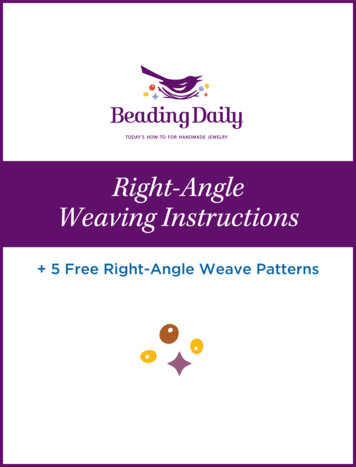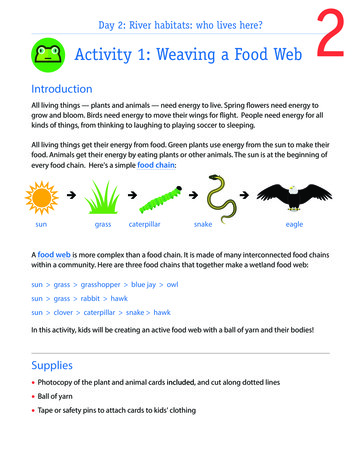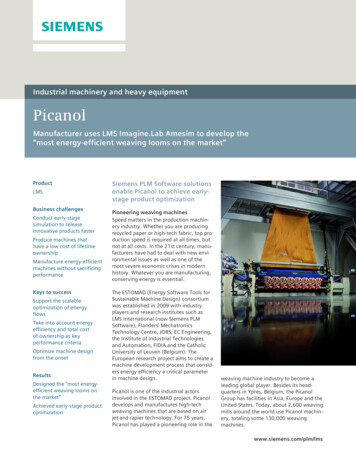
Transcription
March 2005Weaving: The Complete ProcessFrom Thread to ClothSandra Rude, Textile ArtistThree Springs Handworkswww.3springshandworks.comPeople often ask me. “How long did it take to weave that?”The answer I usually give is that the actual weaving, that is, the act of throwing a shuttle back andforth across the loom, is about 10 percent of a complex process. This process includes a lot ofplanning and preparation before the weaving phase begins, and a number of finishing steps after thelast thread is woven.My reason for writing this document is to make it easier for anyone who is not a weaver to understandthe process and to visualize the steps that are necessary to the process.Copyright 2005 Three Springs Handworks. All rights reserved.1
Form Follows FunctionThe first step in any weaving project is to decide what the cloth’s purpose in life will be. The intendedfunction of the cloth guides the weaver in choosing the appropriate thread or yarn. For example, theyarn I use to weave a rug needs to be thick and hard-wearing, and the cloth must be stiff and flat. Itmust not roll up at the edges and trip everyone who walks on it, or if it is to be hung as decorative art,it must lie flat against the wall. A scarf, on the other hand, or any cloth worn next to the skin, shouldbe smooth, soft, and very drapey so it conforms to the body.Because I weave primarily scarves and shawls, and my personal preference is for fine rather thanbulky cloth, I choose very thin thread in natural fibers that are comfortable to wear next to the skin.Silk, lyocell, rayon, cotton, and fine soft wool such as Merino are good choices.There is no set standard for the size of a scarf - some people prefer long and narrow, others prefer ashorter, wider shape. The size of the wearer makes a difference, too. At six feet tall, I am likely towear a longer, wider shawl than a woman five feet tall. Some women like to do the Isadora Duncanfling, with a dramatically long scarf wrapped around the neck once or twice. Some scarves look bestsimply draped over the shoulders. Some scarves have long, twisted fringe, others have short, straightfringe or just a simple hem.In any case, I must make decisions about length and width and end treatment before starting to weave,because these factors determine the amount of thread I’ll need. The design, or pattern, of the clothalso has an impact. What’s the scale of the pattern? Do I choose a nonrepeating pattern? Two repeats?Ten repeats? Fifty repeats?Once I’ve decided what thread to use, I use two kinds of software to help in the planning and designphase:A spreadsheet helps me calculate the amount of yarn I’ll need. You’ll see an example in Figure 1on the facing page. Weaving software lets me program the design of the cloth into the computer. Later, this samesoftware will send the finished design to another computer attached to the loom. This means Idon’t have to remember each step of the design - which can be more than 2,000 threads long - thecomputer remembers it for me. Hey, this is why God made computers! Figure 2 shows an exampleof a design that you will see throughout this document in various stages. 2Copyright 2005Form Follows Function
Figure 1. Spreadsheet for yarn calculationFigure 2. Weaving design softwareForm Follows FunctionCopyright 20053
Dyeing the ThreadI usually buy undyed thread that is wound onto large cardboard cones. I must measure off the numberof yards I’ll need, based on the spreadsheet (with a bit extra just in case) and make skeins for dyeing.Figure 3. Cone of white thread and a measured skeinThen I get to play in the dye-pot! The pictures on the next page show the dye process at variousstages. For the project I’m planning, there will be two colors of warp threads, alternating thread bythread, so I’ll dye half the warp yardage on one color, and half in the other. In this case, the colors aremedium blue and deep blue-green.4Copyright 2005Dyeing the Thread
Figure 4. Skein, pot, and dye suppliesFigure 5. Mixing dyeFigure 6. Skein in dye-potDyeing the ThreadCopyright 20055
Winding the Warp ThreadsThe warp, that is, the lengthwise threads in the cloth, must be measured out to the correct length formy project, and the threads must be kept in order so that they can be wound onto the loom properly.Since it’s awkward to wind a warp with fine threads directly from a skein, I must first wind the threadback onto a cardboard cone. Then I begin winding the warp using a warping mill. Each thread followsthe same path (based on a guide thread that is the same length as the warp will be) and is kept in orderthrough the whole process.Figure 7. Winding thread onto a coneFigure 8. Winding the warp on a warping mill6Copyright 2005Winding the Warp Threads
Once all the threads are measured out to the right length, and in the right order, I put a rod through theloop at one end of the warp and spread the threads out in a toothed board called a raddle. This allowsme to get the warp onto the loom at the width of the finished project. Then I begin winding the warponto the loom.Figure 9. Spreading the warp in the raddleFigure 10. Winding the warp onto the warp beamthrough the raddleFigure 11. Warp brought forward over warp rollerFigure 12. The threading crossThe two sticks in Figure 12 maintain the threading cross, which helps keep those warp threads in thesame order as I placed them on the warping mill.Winding the Warp ThreadsCopyright 20057
Here’s a simplified drawing of the loom, so you can see the essential parts of the loom, and the path ofthe warp threads.PatterncontrollerFront of loomBack of loomShafts (24)and heddlesBeater andreedFront beamWarp rollerWarp beamCloth rollersCloth storagebeamUnwoven warp threadsWoven clothFigure 13. Essential parts of the loomNow I begin what is for me one of the most tedious (but most important) parts of the whole process:threading the warp through the heddles on the shafts. Each warp thread must go through the eye of aheddle attached to the appropriate shaft, according to the pattern design. If I make a mistake here,there will be an unsightly break in the pattern.The pictures on the next page show threading the heddles, drawing the threads through the reed, andtying the warp threads onto the apron rod. (The apron is a sheet of canvas that initially follows thepath shown in green above. As weaving progresses, the apron and then the woven cloth wind onto thecloth storage beam at the back of the loom.) After tying on, I weave a few rows of waste yarn to checkthat the threading is correct and to space the warp threads evenly.8Copyright 2005Winding the Warp Threads
Figure 14. Threading the heddlesFigure 15. Threading (close-up)Figure 16. Drawing threads through the reedwith reed hookFigure 17. Warp lashed onto apron rod; waste yarn woven inWinding the Warp ThreadsCopyright 20059
WeavingOkay, now we’ve almost gotten to the fun part - weaving! First, I wind weft yarn onto a pirn, whichfits into the fly-shuttle. The shuttle will carry the weft yarn across the loom, in the space createdbetween threads that are raised and threads that are not.Figure 18. Winding the pirn.Figure 19. Pirn loaded in shuttleBy the way, I never warp the loom for a single scarf. I always make the warp long enough for at least3 and sometimes 8 or more items. I leave enough length unwoven at the beginning of the warp for thefringe of the first scarf, weave the first scarf, leave enough warp unwoven for the second fringe of thefirst scarf plus the first fringe of the second scarf, weave the second scarf, and so on, one afteranother. This particular project used a technique I’d never woven before, so I only wove 3 scarves onthe warp - some weavers call this “full-sized samples.” Even though all items woven on that warpshare the same warp threads, the weft color and the design can be different for each one, so each isunique.10Copyright 2005Weaving
Here’s a simplified drawing that shows the raised warp threads and the space through which theshuttle travels.1. Pattern controller raises shafts accordingto programmed pattern, thus lifting allthreads connected to those shafts.2. Shuttle passes through spacebetween threads that are liftedand those that are not. Beaterthen swings forward to pressweft into place.Figure 20. Pattern controller raises shafts, creating space for weftFigure 21. Weaving beginsFigure 22. The pattern develops as I weaveWeavingCopyright 200511
FinishingAfter weaving, I cut the warp from the loom. If the scarf will have a plied fringe, I twist the fringebefore washing and pressing the finished scarf. To twist the fringe, I make two little bundles of warpthreads, one bundle in each hand. I twist both bundles in the same direction while letting them twistback on each other in the opposite direction. Sort of like patting your head and rubbing your stomachat the same time. It takes practice, and is hard on the hands, but it makes a lovely fringe for a silk orlyocell scarf. After the scarf is washed and ironed, I’ll even out any group that is too short or too long.Figure 24. Finished fringeFigure 23. Twisting the fringeI do use the washing machine and dryer on most of my scarves, to remove any excess dye and ensurethat the article is pre-shrunk, so you don’t have any surprises after you purchase it.Here are some close-ups of the finished scarves woven on this warp, made by placing the clothdirectly on the scanner bed.12Copyright 2005Finishing
The first step in any weav ing project is to decide what the cloth's purpose in life will be. The intended . medium blue and deep blue-green. Figure 3. Cone of white thread and a measured skein. . cloth storage beam at the back of the loom.) After tying on, I weave a few rows of waste yarn to check .











